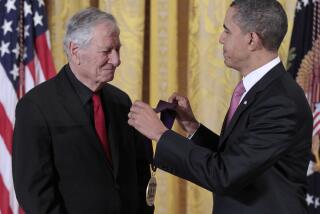The Man Who Unmasked the Pseudo-Event
- Share via
By the end of his career, the Pulitzer Prize-wining historian Daniel Boorstin, who died last weekend at 89, had come to be derided in some quarters as a conservative. In an age that viewed national myths with skepticism, Boorstin celebrated American exceptionalism and touted Western achievements.
Ironically, though, Boorstin’s own signal contribution to the world of ideas lies not in his now-dated Cold War boosterism but in his improbable legacy as a postmodern thinker -- one who became invaluable for comprehending today’s image-drenched public life.
Boorstin’s reputation for conservatism stemmed partly from his pronouncements against liberal shibboleths like affirmative action and multiculturalism, which he issued ex cathedra from his perch as librarian of Congress, a post he held from 1975 to 1987. But the perception of his political orientation also reflected his scholarship, dating to his influential 1953 book, “The Genius of American Politics.”
That tract provocatively praised the absence of theory in American political debate. In contrast to the ideologically driven bloodshed that had scarred Europe, he argued, America’s short life and abundant land had endowed it with a special, salutary pragmatism. Boorstin even interpreted the Civil War as conservative in nature, since both sides claimed allegiance to the Constitution instead of seeking to overturn it.
For stressing continuity rather than conflict in the American past, Boorstin was grouped with contemporaries like Louis Hartz and Richard Hofstadter as “consensus” historians. All of them found broad agreement among generations of Americans on the basic tenets of liberal capitalism -- leaving little room for more radical socialist movements, for example, to develop. But whereas Hartz and Hofstadter lamented the conformity and homogeneity of American thought and politics, Boorstin unapologetically admired it.
Yet if Boorstin’s enthusiasm for American exceptionalism defined his place in his profession, in the wider world of letters he has come to be seen, a bit incongruously, as part of the canon of postmodern thinkers.
One tenet of postmodernism, to put it reductively, is that in advanced societies, reality has come to consist merely of constructed simulacra, with no grounding in material reference. In the 1970s and ‘80s, literary critics, mostly French, elaborated these concepts with a rarefied philosophy and a dense jargon (like “simulacra”). But Boorstin was onto many of these ideas even before the French, though in keeping with his disdain for theory he presented them in plain terms and sprightly prose -- as well as a tone of rueful nostalgia.
The critical work was “The Image: Or What Happened to the American Dream,” published in 1961. A meditation on reality and illusion in the world around us, the book has become well known for many reasons -- including its definition of a celebrity as “a person who is well-known for his well-knownness.” Above all, “The Image” decried the advent of what Boorstin termed the “pseudo-event”: a staged occurrence that’s not intrinsically significant but is created in order to make news -- a press conference, for instance, or the presidential debates of 1960, which Boorstin deplored as specious drama.
At their worst, creators of pseudo-events could wreak havoc; Boorstin considered Sen. Joseph McCarthy “a natural genius at creating reportable happenings” who could garner headlines merely by waving a piece of paper. Ultimately, Boorstin worried, the proliferation of contrived illusions threatened the viability of American democracy as a project in rational self-governance.
Since then, scholars and journalists have used the idea of the pseudo-event to critique virtually every aspect of public life. In recent weeks it’s been used to explain incidents from Howard Dean’s post-Iowa “scream” to the flap over Janet Jackson’s bared breast. Boorstin invented a concept that the culture needed.
In “The Image,” Boorstin also lamented how celebrities, with their manufactured reputations, had displaced the authentic heroes he admired -- those who earned fame through genuine innovations in leadership, science or the arts. Boorstin then reexamined such innovators in his later works, paying homage to intellectual adventurers from Columbus and Copernicus to Einstein and John Maynard Keynes.
Boorstin had his ideological blind spots, but in his long, idiosyncratic career, he managed to proffer a few real discoveries of his own -- meriting him a modest place in the history of human thought that he strove to understand.
More to Read
Sign up for our Book Club newsletter
Get the latest news, events and more from the Los Angeles Times Book Club, and help us get L.A. reading and talking.
You may occasionally receive promotional content from the Los Angeles Times.










